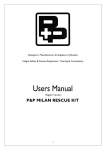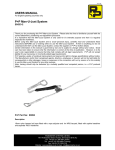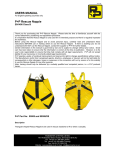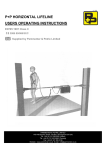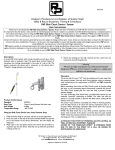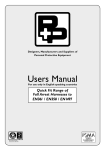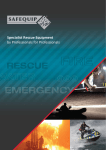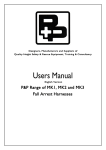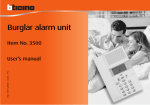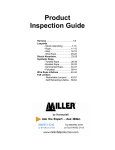Download online PDF manual
Transcript
Designers, Manufacturers and Suppliers of Personal Protective Equipment Users Manual English Version P+P STANDARD RESCUE KIT 1 Thank you for purchasing this P+P Standard Rescue Kit. Please take time to familiarize yourself with the correct use and operation. It is imperative that this P+P Standard Rescue Kit is only used for its intended purpose and that it is subject to a periodic recorded detailed inspection by a competent person. To avoid personal injury, prior to using this P+P Standard Rescue Kit or training others to use it, CAREFULLY READ and understand these instructions. If there is anything you do not understand DO NOT use the P+P Standard Rescue Kit, contact the supplier or P+P for further details. Certain information in this manual is governed by law and is subject to change without prior notice. Great care has been taken to ensure that the information is correct at the time of publication. However, it is the user’s sole responsibility to ensure that they fully comply with all legal requirements. P+P will not accept liability for any inaccuracy or incorrectly stated legal requirements. P+P operate a policy of continual improvement and reserve the right to change specifications without notice. The Manufacturer and / or their recognised agents, directors, employees or insurers will not be held liable for consequential or other damages, losses or expenses in the connection with or by reason of or the inability to use the P+P Standard Rescue Kit for any other purpose. Note; training should only be delivered by a suitably qualified and competent person, i.e. a P+P products trainer. Description recommended that the user is given adequate practical training prior to using this system. The Pammenter & Petrie (P+P) Standard Rescue Kit is a pre-rigged single person rescue kit that is both simple and quick to use. The equipment is used to perform a ‘cut and lower off’ rescue of a casualty suspended at height, to a point of safety. The P+P Standard Rescue Kit can also be used to perform a ‘self rescue’ by abseiling to a point of safety. The P+P Standard Rescue Kit comes complete with 11mm low stretch kernmantle rope and an Anthron descender. A P+P round sling is used to connect to the scaffold or similar attachment point. At the casualty end of the rope is a kwiklock karabiner for easy attachment to the casualty’s harness attachment (D-ring or loop). The equipment is contained in an easily transported rescue bag complete with rescue shears. DO NOT use the system until you have read and fully understood these instructions. IF IN DOUBT, CHECK BACK WITH THE SUPPLIER OR P+P. Diagram 1 Anchorage round sling and karabiner Standard rope length 20 metres Custom rope lengths are available upon request. Rescue Bag Function The P+P Standard Rescue Kit is used in conjunction with a P+P full body harness to EN361 to provide a rescue recovery system. P+P recommend that users are trained in the proper use and practical/physical limitations of this system. Equipment specifiers / users must ensure this device is used with compatible ropes and connectors. Failure to ensure compatibility may result in an unsafe condition or even connector/link failure. Anthron Descender Warning All work at height including the use of Personal Protective Equipment (PPE) as a control measure is subject to a suitable and sufficient risk assessment. Rescue Shears Rescue Rope Kwiklock Karabiner Usage This Standard Rescue Kit is for personal use only. Only use EN362 connectors (hooks, karabiners etc.) approved and recommended by P+P. Check the inspection record for this system to ensure that regular inspections have been correctly recorded. It is strongly 2 • Do not loop the rope over a structure with sharp edges. Ensure edge radius is greater than 5mm. • Do not allow the rope to become slack – adjust the Anthron descender to immediately take up any rope. Warning Selection of a suitable anchorage point is critical and must in all cases be above the casualty and capable of taking a peak force of 10kN. This is usually a structural strong point or anchorage to BSEN 795. Do • Do check the Anthron descender for correct operation – before using. • Do check all connectors are correctly attached and their respective gates properly closed. • Do check the rope is always kept taut and never allowed to become slack. Instructions for use 1. Safely access the casualty, ensuring that the rescuer is attached to the structure at all times with suitable fall protection equipment. 2. Position the rescue bag onto the structure and lift out the rescue unit. 3. Select a suitable anchorage or structural strong point directly above the casualty. The anchorage must be capable of taking a shock force of 10kN. 4. Attach the Anthron descender to the anchorage using the P+P one metre round sling and Screwgate karabiner ensuring the karabiner gate is closed and screwed up tight. 5. Squeeze the handle on the Anthron descender to allow the rope to be extended to the required length. (Please see note A). Ensure that there is not too much rope paid out to eliminate any possible drop during the cut phase of the rescue. 6. Attach the rescue rope to the casualty’s harness attachment point (D-ring or loop), ensuring that the gate on the Kwiklock karabiner is fully closed and secure. 7. Identify the casualty’s used fall arrest lanyard (or similar fall protection product). 8. Double check that all connections are secure. 9. Holding the rescue shears in one hand, control the rescue rope by holding the free rope coming from the rescue bag with the other and cut the casualty free from their used fall arrest lanyard (or similar fall protection product), cut away from the rescue rope. 10. The casualty can now be lowered to a point of safety by squeezing the handle on the Anthron descender to allow the rope to pass through the unit. (Please see note A). Always control the rate of descent by feeding the free rope coming from the rescue bag into the Anthron descender with the other hand. 11. Ensure that a uniform rate of descent is maintained and that the casualty does not hit the position of safety too fast. It is strongly recommended the user is trained in its proper use and practical/physical limitations. Modifications and Repairs No repairs, modifications or alterations are to be carried out on this P+P Standard Rescue Kit. Inspection Keep these instructions or a copy with the P+P Standard Rescue Kit for future reference to assist with inspections and safety checks. • • • • • • (Note A) The Anthron descender is a ‘Double Braked Unit’. With the handle released the rope will not pass through, to allow the rope to pass the handle must be squeezed by hand to reduce the amount of friction. If the handle is squeezed too much the friction is re-applied and the rope will once again not pass through. Therefore, the rescuer must be in control of his/her actions at all times as the Anthron Descender has a fail-safe “antipanic” design. The equipment is subjected to a thorough visual and tactile inspection after manufacture and before packaging. It is then sealed into the rescue bag. Upon delivery to site ensure that the seal is intact. This initial inspection must be recorded. P+P recommend that at the start of every working day the equipment is checked to ensure that the seal is still intact and that the rescue bag is not damaged or contaminated. P+P also recommend that a recorded inspection of the seal and integrity of the rescue bag is carried out at least every 6 months (3 monthly in hazardous environments). This recorded inspection should be carried out by a competent person. After use the equipment should be removed from service until it has been subjected to a thorough visual and tactile inspection by a competent person. This interim inspection must also be recorded. P+P can perform this “after use” inspection and replace any worn or damaged parts as required. The kit will then be re-sealed as when new. Whilst in use particular attention should be paid to the following: • Metal components – inspect for signs of damage, distortion or corrosion, – ensure correct operation and locking of all connectors, • Rescue rope – inspect for signs of wear or abrasion, – ensure that the rope does not run over sharp or abrasive edges or protrusions whilst under tension, – inspect for signs of unravelling or extension, – check for any reduction in the diameter of the rope Do Not • Do not use this system until you have read and fully understood these instructions. • Do not anchor to a structure that itself can fall i.e. loose or unsecure structure. 3 All Personal Fall Protection and Rescue Equipment should be immediately removed from service after being subjected to a shock load, or if there is any doubt about its condition or integrity. Warning This P+P Standard Rescue Kit must be used by persons who are medically fit to do so. If you have any medical condition, are recovering from any medical condition or suffer from any physical or mental disability you must seek professional medical advice before using this rescue system Cleaning, Maintenance and Storage Statement of Obsolescence The P+P Standard Rescue Kit can be cleaned if required. The following cleaning method must be adhered to. • Use hand hot water and mild detergent only, • Use a cloth or sponge to wipe the equipment, do not soak, saturate or over wet the kit, • Repeat the above with fresh, clean water to rinse, • Allow to dry naturally before re-packing, do not force dry with direct (e.g. central heating radiator) or indirect (e.g. hot air blower) heat sources, • After cleaning the equipment should be removed from service until it has been subjected to a thorough visual and tactile inspection by a competent person. This interim inspection must be recorded. Due to the ingress of dirt and grit, chemical contamination, edge and surface damage, ultraviolet light degradation, and wear and tear, Fall Protection Equipment manufactured from synthetic fibres (webbing and/or rope) is subject to a manufacturer’s statement of obsolescence, which is a requirement of BS EN 365:2004 a European Product Standard. Any item of Fall Protection Equipment manufactured by Pammenter & Petrie Limited with synthetic fibre components (webbing and/or rope) is subject to a maximum working life of 5 years from the recorded date of first use, provided that the item has been correctly stored, maintained and subjected to regular inspections by a trained and competent person. However, if the item fails any inspection it MUST be destroyed. All safety and rescue equipment should be stored and transported in the following way: • In a cool and dry environment, • With no direct heat or sunlight, • Under no strain or pressure, • Not subjected to undue dust or contaminates, • Away from harmful chemicals or substances, • Dry, A new item of Fall Protection Equipment manufactured by Pammenter & Petrie Limited may be stored for a maximum of 2 years and will still give the potential 5 year working life provided it remains in the original manufacturer's packaging. Once the product is taken from this original packaging for the first time, this date becomes the “date of first use", which should be recorded on the Inspection Record and the 5 year working life begins. • In an appropriate bag, box or cabinet. Reference should also be made to the British Standard BS 8473:2005 - "The code of practice selection, use and maintenance of personal fall protection systems and equipment for use in the workplace" - clause 13.2 Lifespan, which states: Chemical Attack Avoid contact with any chemical, which might affect the performance of this product, e.g these include all acids and strong caustic substances (vehicle battery acid, bleach etc) If subject to chemical attack, you must remove it from service and check with the supplier or P+P for advice on the possible consequence of chemical degradation. "Some equipment is given a life span or obsolescence date by the manufacturer. Equipment that has reached such a limit, which has not already been rejected for other reasons, should be withdrawn from service and not used again, unless or until confirmed by a competent person, in writing, that it is acceptable to do so." Service Life About This Manual It should be noted that inspections carried out by a trained and competent person are only visual and tactile observations of the condition of the product; they are not testing the residual strength of the equipment. All synthetic fibres deteriorate slowly with age regardless of use and as a result, Pammenter & Petrie Limited strongly advises all users of Fall Protection Equipment to follow the manufacturer's statement of obsolescence. This User Manual is for English speaking countries only. If you require this manual in a different language, please Contact P+P. When this item is sold on, this manual must accompany it and be supplied in the language of the destination country. For further advice on this statement, as well as training in the use and inspection of Fall Protection Equipment, please contact Pammenter & Petrie Limited. The P+P Standard Rescue Kit has a maximum working life of 5 years from date of first use, provided it is correctly stored and maintained. However, if the system fails any inspection it MUST be destroyed. See the Statement of Obsolescence within this manual. Product Details The Product Code, Serial number and Date of Manufacture of the P+P Standard Rescue Kit should be entered on the back page of this manual for future reference and inspection purposes. 4 5 Designers, Manufacturers and Suppliers of Personal Protection Equipment P+P STANDARD RESCUE KIT PRODUCT NAME:……………………………….. PRODUCT CODE:………………………………... SERIAL NUMBER:……………………………….. DATE OF MANUFACTURE:……………………. P+P Limited, 140 - 146 Brearley Street, Hockley, Birmingham B19 3XJ, England. Telephone: 0121 359 4561 Facsimile: 0121 359 4136 Email: info@pammenter.co.uk Website: www.ppsafety.co.uk This Manual and its contents © P+P Limited 2009 P+P Standard Rescue Kit V 5_1009 All rights reserved. No part of this publication may be reproduced, stored in a retrieval system, or transmitted, in any form or by any means, electronic, mechanical, photocopying, recording or otherwise, without the prior permission of P+P Limited. Pammenter & Petrie Limited, 140 - 146 Brearley Street, Hockley, Birmingham B19 3XJ, England. Tel: +44 (0)121 359 4561 Facsimile: +44 (0)121 359 4136 e-mail: info@pammenter.co.uk website: www.ppsafety.co.uk Registered in England No. 1493537 6






